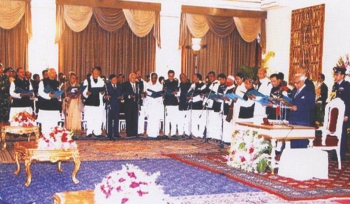| Home - Back Issues - The Team - Contact Us |
 |
| Volume 11 |Issue 36| September 14, 2012 | |
|
|
Current Affairs The Supreme Leader Shakhawat Liton
On September 8, Prime Minister and ruling Awami League chief Sheikh Hasina, at a meeting with leaders of her party's associated and like-minded bodies said her party would set a record by returning to power through the next parliamentary polls. It's true it will be a record if her party is able to return to the power through a free, fair and participatory election. Returning to power by any means, like holding a name-only election, will not set any positive record as her archrival BNP Chairperson Khaleda Zia has already set that record through the farcical ballot held on February 15, 1996. Therefore Hasina and her government need to do more to create an atmosphere conducive to a participatory poll. This is hardly possible if the BNP-led 18 party opposition does not take part in the elections. The current political situation suggests that the BNP-led alliance will not join the next polls if it is held under the AL-led government without restoring the caretaker government. Thus time will tell how the ruling AL under leadership of Hasina will set the record. Personally, Hasina has already set a record by leading the AL for the last 32 of the 63-year life-span of the party. Moreover, she has emerged as the supreme leader of her party and cabinet. Currently, there is no one within her party and her cabinet to question her leadership. She is fortunate more than even her father Bangabandhu Sheikh Mujibur Rahman, who was the supreme leader of the country. But Bangabandhu did not enjoy such supremacy in his party AL as he had to sometimes take some measures, such as personal intervention or accommodation of factional leaders in powerful positions, to minimise internal conflicts in the party. For instance, after the liberation of Bangladesh, the AL formed the government. In February of 1972, the AL working committee at a meeting in Dhaka decided to separate the party organisation from the government. It meant that ministers were barred from holding any party position. But the factional fights within the AL forced Bangabandhu to continue as party president. And in the following year, in the earlier part of 1973, the factional fights kept increasing. Jubo League chief, Sheikh Fazlul Haq Moni and Sramik League leader Abdul Mannan, started a purification drive within the party. Bangabandhu was compelled to personally mediate between the factions. But mere mediation did not yield positive results. In September of 1973, Bangabandhu had to expand his cabinet by appointing fourteen state ministers to keep the support of some factional leaders. In December the same year, he inducted two more ministers into his cabinet. Analysing the situation, eminent political scientist Prof Rounaq Jahan in his book titled Bangladesh Politics: Problems and Issues observed: “Thus Sheikh Mujib averted an open division of the party by judiciously balancing the various factions and distributing political patronage among them.”
Bangabandhu's daughter Hasina is fortunate as she does not need to distribute political patronage to minimise factional fights. In the last three and half a years, she distributed political patronage among leaders blindly loyal to her leadership. And in so doing, she cleared the way for her emergence as the supreme leader both in her party and the cabinet. Hasina sets a record! How long will Sheikh Hasina continue as party chief? It is very difficult to answer this question. There is no rule in the charter of AL that can prevent Hasina from leading the party after a certain period. Therefore, there is no bar on her to lead the party for life! Hardly surprising then that AL General Secretary and LGRD Syed Ashraful Islam on June 23 on the party's anniversary remarked: “Sheikh Hasina led the AL 32 years out of 63 years. During the 32 years, she freed the country from the clutches of a military dictator, militants, and anti-liberation forces. She has to lead the AL for 32 years more than country's independence and sovereignty will be protected.” Wind of change! Thus within the year 2009, Hasina consolidated herself as the supreme leader in both the cabinet and party. Therefore, her cabinet remained free from scrutiny by the party over the last three and half a years. Similarly, the cabinet did not face much criticism in parliament for any of its actions or failures as Hasina is also the leader of the House. What's the outcome of such supreme leadership? The party's electoral pledge “A Charter for Change” has remained largely unfulfilled. The quality of governance has not improved, rather deteriorated to a large extent in many areas. Her government is now embattled by problems like the share market scam, alleged corruption in the Padma bridge project and the Hall-Mark loan fiasco. Every time her government has failed to take stern steps to regain people's confidence in her leadership. In the wake of the prevailing situation, only she knows how her party will set a record by returning to power through the next parliamentary polls. And time will give us the answer! The writer is Senior Reporter, The Daily Star.
Copyright
(R) thedailystar.net 2012 |
||||||||

